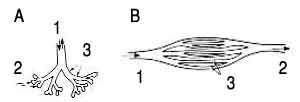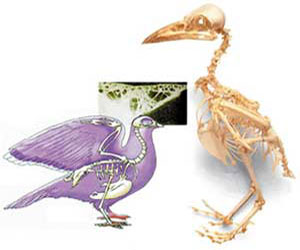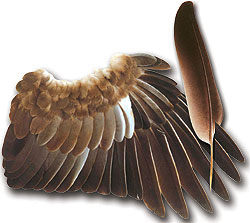Birds and Reptiles
Evolutionists make the claim that birds evolved from reptiles. When we examine the structure of these two living classes, however, we see that this assertion is extremely unscientific.
Evolutionists claim that birds evolved from small-structured, reptilian dinosaurs. A comparison between birds and reptiles, however, demonstrates that these living classes are very different from each other and no evolution whatsoever could have taken place between them.
 |
THE DISTINCTIVE TRAITS OF REPTILES In the world of vertebrates, reptiles are one of the groups that least resemble birds. While birds are warm-blooded, reptiles are not even capable of producing their own body heat. With the structure of their skin, their metabolism, and their skeletal system, reptiles are ultimately created to live on land. |
There are many structural differences between birds and reptiles. The most important one is their bone structure. Dinosaurs, the alleged ancestors of birds, according to evolutionists, have thick and solid bones because of their massive structure. Whereas the bones of living and extinct birds are hollow and thus very light. This light-weight bone structure is very important in the flight of birds.
 | Reptile Lung and Bird Lung Bird lungs function in a completely contrary way to land animal lungs. The latter inhale and exhale through the same air passages. In birds, while the air enters the lung from the front, it goes out from the back. This distinct "design" is specially made for birds, which need great amounts of oxygen during flight. It is impossible for this structure to have evolved from reptile lungs, because respiration would be impossible with an "intermediate" form between these two different lung structures. |
A. Reptile Lung: 1.Air entry-exit, 2. Alveol, 3. Bronchia B. Bird Lung: 1. Air entry, 2. Air exit, 3. Parabronchia |
Another important difference between reptiles and birds is their metabolic structure. While reptiles have the slowest metabolic rate in the world of living things, birds hold the highest records in this field. For instance, the body heat of a house sparrow can rise up to 48oC because of its fast metabolism. On the other hand, reptiles are not even capable of producing their own body heat and instead warm up under the sun. Reptiles are the least energy-consuming animals in nature, whereas birds are the most energy-consuming animals.
 |  |
BIRDS' SPECIAL SKELETAL SYSTEM Unlike dinosaur and reptile bones, bird bones are hollow. This gives the body stability and lightness. Birds' skeletal structure is employed in designing aeroplanes, bridges and other structures in our own time. | THE FUNCTION OF FEATHERS Unlike reptiles, the bodies of birds are covered with feathers. Responsible for the aerodynamic function in birds, feathers also help them retain their body heat. |
The respiratory system of birds also differs greatly from that of reptiles. Reptiles and mammals take air into their lungs through their trachea and then give it back through the same pipe.
 |
FEDUCCIA'S DENIAL Famous ornithologist Alan Feduccia thinks that the theory of the evolution of birds from reptiles is simply nonsense.
|
In birds, however, air makes a one-way journey through the lung channels; it enters from one side and departs from the other. Thanks to this respiratory system that does not exist in any other living class, birds make extremely efficient use of air. This system enables them to fly even at an altitude of 8,000 meters, where oxygen is very scarce.
Another characteristic that raises an unsurpassable barrier between birds and reptiles is feathers, a structure specific to birds. The bodies of reptiles are covered with scales, whereas the bodies of birds are covered with feathers.
Put briefly, numerous differences between birds and reptiles definitively refute the evolutionist claim that reptiles gradually evolved into birds. Birds and reptiles are living classes God created to be quite distinct from each other.
Alan Feduccia, a professor from the University of North Carolina, strongly opposes the theory that birds have a kinship with dinosaurs on the basis of scientific discoveries, despite the fact that he is an evolutionist himself:
Well, I've studied bird skulls for 25 years and I don't see any similarities whatsoever. I just don't see it... The theropod (a major group of dinosaurs) origins of birds, in my opinion, will be the greatest embarrassment of paleontology of the 20th century.33
- An Outdated View: The Theory of Evolution
- The Origin of Life
- The Design in the Protein
- The Design in the Cell
- Genetic Information
- The Design in Nature
- Miller's Experiment
- The Natural Selection Misconception
- Mutations
- Irreducible Complexity
- Impasse of Intermediate Forms
- The Cambrian Period
- Fish and Amphibians
- Coelacanth Misconception
- Reptiles
- Birds and Reptiles
- Archaeopteryx Misconception
- Bird Feathers
- The Origin of Mammals
- Living Fossils
- The Tale of Man's Evolution
- Australopithecus
- Homo Erectus
- A Lost Human Race: Neanderthals
- The Collapse of the Family Tree
- The Bipedalism Impasse
- False Faces
- Piltdown Scandal
- Why is Evolution Defended?
- The Obvious Truth: Creation
